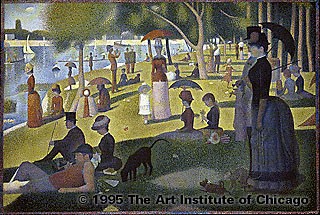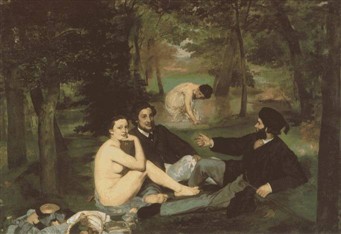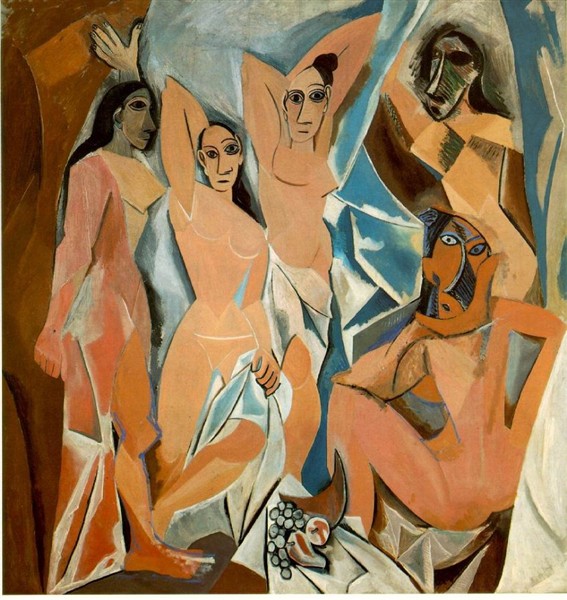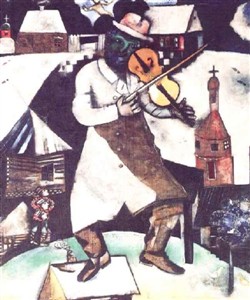Runes konstgalleri
Rune var mycket konstintresserad. Han visste mycket av konst, han njöt av konst och han målade även lite själv.
 Georges Seurat (French, 1859-1891) A Sunday on La Grande Jatte -- 1884, 1884-1886 Oil on canvas; 81 3/4 x 121 1/4 in. (207.5 x 308 cm) Helen Birch Bartlett Memorial Collection, 1926.224 Georges Seurat (French, 1859-1891) A Sunday on La Grande Jatte -- 1884, 1884-1886 Oil on canvas; 81 3/4 x 121 1/4 in. (207.5 x 308 cm) Helen Birch Bartlett Memorial Collection, 1926.224
"Bedlam," "scandal," and "hilarity" were among the epithets used to describe what is now considered Georges Seurat's greatest work, and one of the most remarkable paintings of the 19th century, when it was first exhibited in Paris. Seurat labored extensively over A Sunday on La Grande Jatte--1884, reworking the original as well as completing numerous preliminary drawings and oil sketches (the Art Institute has one such sketch and two drawings). With what resembles scientific precision, he tackled the issues of color, light, and form. Inspired by research in optical and color theory, he juxtaposed tiny dots of colors that, through optical blending, form a single and, Seurat believed, more brilliantly luminous hue in the viewer's eye. To make the experience of the painting even more intense, he surrounded it with a frame of painted dots, which in turn he enclosed with a pure white, wooden frame, which is how the painting is exhibited today. As to the meaning of these Parisians enjoying a day off on an island in the Seine--who they are, where they come from, and what they are doing--their very immobility and that of the shadows they cast makes them forever silent and enigmatic. Like all great masterpieces, La Grande Jatte continues to fascinate and elude, with our explanations of it revealing perhaps more about us than about the painting itself.
 This is Picasso's Guernica painted in 1937 This is Picasso's Guernica painted in 1937
The images I will show you are difficult to see until you know how to look at the picture, but they are all visible without artificial aids once you know where to look. I believe that these images have not been seen before, yet they are startling and necessitate a new assessment of this great picture and one of the methods Picasso used to create his paintings.
Guernica was not the first picture in which Picasso appears to have used a naturalistic image on which he superimposed stylised or abstract images to such effect that the original image is hard to see. There are many pictures painted in the 1930's and 40's which were painted using this technique.

1863; Luncheon on the Grass; Musee d'Orsay; Oil on canvas, 81 x 101 cm
The active spirit of independance in Impressionism --- if not its style --- may be considered to date from this famous work, refused by the Salon in 1863 and exhibited, under the title of Le Bain at the Salon des Refusés of the same year. It is the larger of Manet's two versions of the subject, a smaller and freer version being in the Courtauld Institute Gallery in London. According to Antonin Proust, the idea of the picture suggested itself to Manet when they were watching bathers at Argenteuil. Manet was reminded of Giorgione's Concert Champêtre and determined to repeat the theme in clearer colour and with modern personnel. A closer likeness of composition has been found in an engraving by Marcantonio of a group of river gods, after a now lost original by Raphael of The Judgement of Paris. An Old Master element of formal arrangement remains to distinguish it from an essentially Impressionist work and yet as well as being ostensibly set in the open there are various hints and suggestions in light and colour of fresh possibilities in open-air painting. The furious outcry it caused as the principal exhibit among the Salon rejects was based on the alleged indecency of two fully-dressed men appearing in the company of the naked female bather (an accusation no one had thought to make against the comparable juxtaposition in the work attributed to Giorgione). But the respectable persons represented in sedate conversation were Manet's favourite model, Victorine Meurend (whom he also painted as a toreador), his brother-in-law, Ferdinand Leenhoff, and Manet's younger brother, Eugène.
Public hostility not only helped to make Manet a hero in the eyes of the young painters but brought together in his support the group from which the Impressionists emerged.

Pablo Picasso. Born Malaga, Spain 1881; died Mougins, France 1973. Les Demoiselles d'Avignon 1906; oil on canvas; 244 * 234 cm; Museum of Modern Art, New York, USA
Pablo Picasso's painting LES DEMOISELLES d' AVIGNON, marks the beginning of Cubism, a revolutionary artistic movement initiated by Picasso and his fellow artist Georges Braque. Picasso first started work on this painting in his Parisian studio in 1906. The final composition shows clearly the influence of both Cézanne, who had famously declared that all nature was based on the sphere, the sylinder and the cone, and the simplified forms that Picasso had found in African art. The right-hand side of the painting, in particular, with its flat shapes and mask-like heads, shows what a dramatic break with tradition this was. Although Picasso is primarily associated with Cubism, his so-called Blue Period, with its melancholic depiction of lowlife, was another significant early phase in his development. from 1914 onward, his work evolved in many other directions. Paintings, drawings, collages, etchings, sculptures, stage designs and ceramics were produced at an astonishing rate with subjets as diverse as classical mythology and the horrors of war. After exhibiting with the Surrealists in 1925, he continued to experiment with characteristic energy and confidence until his death, aged ninety two, in 1973. He was indisputably a genius and the founder of modern art.

The Fiddler, 1912-1913, Oil on Canvas, National Gallery of Art, Washington DC, USA.
|